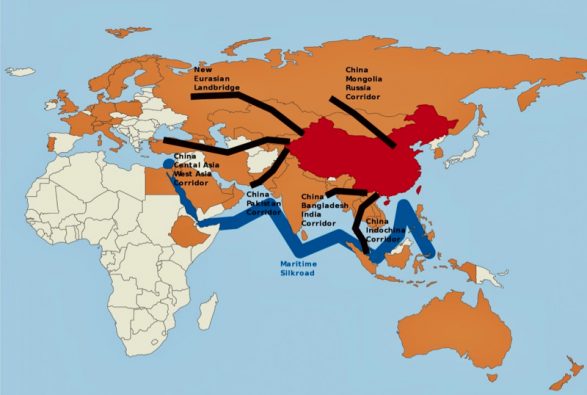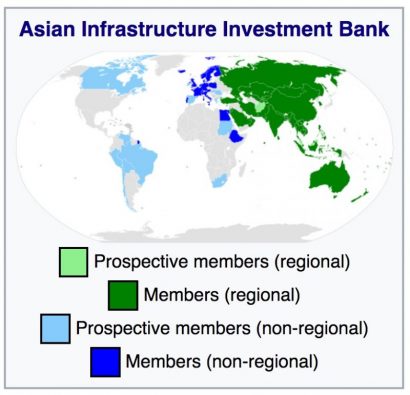
Black indicates proposed land-transport corridors. Blue: the Maritime Silk Road. Orange: members of AIIB [Asian Infrastructure Investment Bank]. Image from Wikipedia
Very recently (Aug 13, 2017), NZ China Council Executive Director Stephen Jacobi spoke to Radio New Zealand’s Wallace Chapman about the ‘Belt and Road Initiative’ and he explained why New Zealanders should care about the initiative.
“In March of this year, New Zealand and China signed a ground-breaking Memo of Arrangement concerning the Belt and Road Initiative.” Chapman opened by explaining that the ‘Belt’ is the Silk Road between Central China, West Asia and the Middle East and on to Western Europe. The ‘Road’ will be the ’21st Central Maritime Silk Road’ from Southern China to East coast of Africa to the Persian Gulf.
Stephen Jacobi stated: “This is a ground-breaking new idea to facilitate economic relations, improve trade routes as well as hasten transport times across a vast area, but this Memorandum is a different level of agreement to the normal ‘Understanding’. Rather, it is a way of progressing to see what measures can be constructed to facilitate the above.
“This may sound new but it is simply an updated version of China’s ancient Silk Road which was established millennia ago and linked Central China to W. Asia, the Middle East and on to Western Europe.
“The original road was built to provide opportunities to market China’s vast stores of silk, a product in huge demand. But the Silk Road did far more – it encouraged cities to develop where none had been before and connected widely differing peoples spreading religions and cultures far afield from their origins. Gradually influence and power moved to Europe and now North America but it is returning again in some cases back to Asia.
“Xi Jinping, China’s paramount leader suggested, on a 2013 visit to Kazakhstan, the Silk Road Economic Belt and the 21st Century Maritime Silk Road linking Chinese Eastern Coast to southern most coast and on to India and East Africa and out to the Persian Gulf and the Red Sea. Since then it has grown into a massive concept which China is hoping will link economies once again.
Chapman pointed out: “This trillion dollar project has generated some scepticism from detractors who suggest that it is China’s way of influencing other countries, and several Pacific countries such as Fiji and Tonga have already developed infrastructures in co-operation with China.”
Jacobi agreed that has been some sceptisim but underlined that each country perceives its own interest in the scheme.
“The scale of this modern day Silk Road will be amazing. Already there is interest in developing a rail line from Eastern China to London. It will carry goods which hopefully will be delivered without the numerous regulations and jurisdictions which are presently required between countries.
“In recent years, New Zealand has upgraded its links to China, with free trade agreements and the like but there will not be any rail-funds provided under the Belt and Road Initiative.” The aim of New Zealand will be how we can improve our goods and services along the road. New Zealanders have great expertise in this and can assist China in greater connectivity between the two countries. This will be an opportunity to revise how we want to work with China to the benefit of both.” [However, New Zealand has already signed up to the One Belt One Road-related Asian Infrastructure Investment Bank, see Note below.]
Jacobi ended by saying that “New Zealand requires a softer approach in the form of trade facilitation, regulations understanding and customs co-operation which could come from the ‘One Belt-One Road Initiative”.
Radio New Zealand podcast “China Belt and Road: why should we even care?”
Aug 13, 2017
To listen to the complete interview click HERE
Notes:
Jacobi recommended reading ‘The Silk Roads – A New History of the World’ by Peter Frankopan, Bloomsbury Publishing (27-08-2015) ISBN 9781408839973.
** The official name of the initiative is ‘The Silk Road Economic Belt and the 21st-century Maritime Silk Road’ (Traditional Chinese 絲綢之路經濟帶和21世紀海上絲綢之路, Simplified Chinese 丝绸之路经济带和21世纪海上丝绸之路)
Note that New Zealand was among the first states to ratify its membership of the Asian Infrastructure Investment Bank (signed, Jun 2015, and ratified, Dec 2015) that will be a major player in financing the One-Belt One Road Initiative.
Members of AIIB – Asian Infrastructure Bank (set-up 2015):

See also:
In March we published an article The One-Belt-One-Road Initiative – a Chinese development plan which could interest NZ in which we gave a broad outline of the plan.
The Wikipedia article on ‘Belt and Road Initiative – 一带一路’.
China is already preparing the way for the ‘One Belt One Road’ development of the Beijing to London rail link, by increasing educational establishments in the Hexi Corridor – for example, the Baillie International Vocational College in Shandan, Gansu province, is under construction for completion in 2018.




